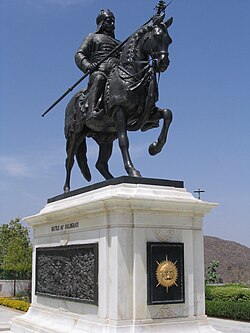| Princely state |
|---|
| Individual residencies |
| Agencies |
|
| Lists |
During the medieval and later feudal/colonial periods, many parts of the Indian subcontinent were ruled as sovereign or princely states by various dynasties of Rajputs.
Contents
The Rajputs rose to political prominence after the large empires of ancient India broke into smaller ones. The Rajputs became prominent in the early medieval period in about seventh century and dominated in regions now known as Rajasthan, Delhi, Haryana, Western Gangetic plains and Bundelkhand. [1] [2] [3] [4] [5] [6] [7] [8] [9] [10]
However, the term "Rajput" has been used as an anachronistic designation for Hindu dynasties before the 16th century because the Rajput identity for a lineage did not exist before this time, and these lineages were classified as aristocratic Rajput clans in the later times. Thus, the term "Rajput" does not occur in Muslim sources before the 16th century. [11] [12] [13] [14] [15] [16]

